Orchid seed germination history
The popularity of the orchids began in the early 19th century, when the first plants were blooming, brought by travelers with great hardships from foreign countries. The exotic and spectacular blossoms increased the demand rapidly and a true import industry developed. Adventurers traveled to places far away from home to find new and rare orchids and bring them to Europe. There were no protection regulations at that time and so entire habitats were looted for the money. The few plants that survived the long and burdensome journey were propagated by the gardeners by dividing the plants. The available quantity of young plants was not nearly enough to satisfy the demand of the people and so the robbery of the plants continued from the nature.
Since it is in the nature of every gardener to want to multiply his plants, even then there were attempts to propagate the orchids via seeds - unfortunately only with very little success. Apart from a few random successes, which were hardly reproducible, there was no significant progress in sowing. In 1832, John Lindley mentioned that in Chiswick (London) it was possible to rise young plants of Prescottia plantaginea from seeds. Unfortunately, there are no details on the procedure and the seedlings ended up as alcohol preparations. A little later, in 1849, David Moore (Nelson 2002) reported that in the botanical garden of Glasnevin (Dublin), it was possible to grow seedlings of Thunia bracteata and Epidendrum crassifolium od. ellipticum from seeds and bring them to flower. The ripe dry seeds distributed Mr. Moore in the area of the parent plants on branches and the substrate surface of the pots. Since the source material was imported plants, it can be assumed that a useful symbiosis fungus came to Europe together with the orchids and helped with germination.
True momentum came into the thing at the beginning of the 20th century. The french botanist Noël Bernard (1874 - 1911) recognized that orchid seeds need a symbiotic fungus for germination. Based on this finding, he developed the first symbiotic in vitro seed germination procedure. Unfortunately, the french researcher died much too early and his german colleague and letter contact Hans Burgeff (1883 - 1976) alone had to continue Bernard's work. Already in 1911 he published the book "Die Anzucht tropischer Orchideen aus Samen" (Burgeff 1911) on whose contents I would like to elaborate.
In the introduction he explains very understandably and with many pictures the fungal symbiosis of the orchids. I was particularly impressed by the detailed drawings and photos, one of which can be seen in figure 1.
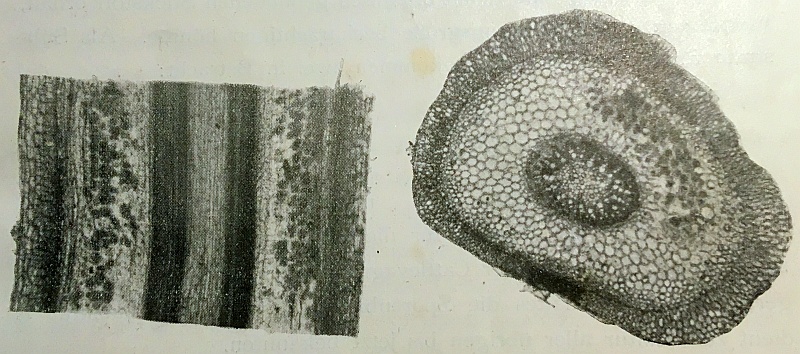
Burgeff extracted from the inside of a root a piece of tissue that contained the symbiotic fungus. The tissue on the root surface would have been easier to extract, but there are also other contaminants (bacteria and fungi that are not well tuned to the orchids) present that you do not want to isolate. The extracted tissues were placed in a nutrient-poor medium to grow in it. Media with a lot of nutrients can not be used because the fungi will grow fast into one another, thereby making isolating the individual fungi impossible. By regularly transferring the fungi to fresh media, the individual fungi were separated and propagated. The seeds from still closed, as mature as possible orchid seed capsules were applied to media, which were colonized by the isolated fungi. Those fungi which helped to germinate the seed were further cultivated and used for sowing the remaining seeds. Figure 2 shows seedlings that were grown according to the method described in test tubes (in vitro) by Hans Burgeff.
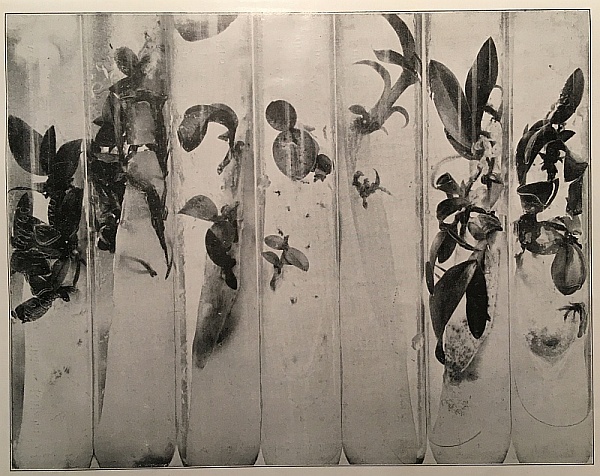
In addition to the in vitro seeding method described above, Burgeff also describes sowing on fungi-infected substrates such as sphagnum mixed with Polypodium or Osmunda. At the beginning, the substrate must be freed from as many contaminants (fungi and bacteria) and pests as possible - but it does not have to be completely free of contaminations. This was achieved by putting the mix in pots in a steam pot for about 1.5 hours. After cooling, pieces of isolated and compatibility-tested fungi were transferred into the pots. The pots so inoculated came in a bell jar as shown in Figure 3 and were set up in moderately warm conditions. Lost water was returned to the substrate via the bell neck. Boiled rainwater was used.
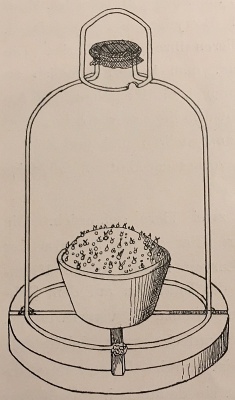
Depending on the type of symbiotic fungus used, it took 3 to 9 weeks for the substrate to be completely colonized by the fungus. After that, the orchid seeds were spread on the substrate surface and the pots placed back in the glass bells. The care continued to be limited to replacing the leaked water. Figure 4 shows such a sowing pot with 9-month old seedlings of Vanda suavis x Vanda teres.
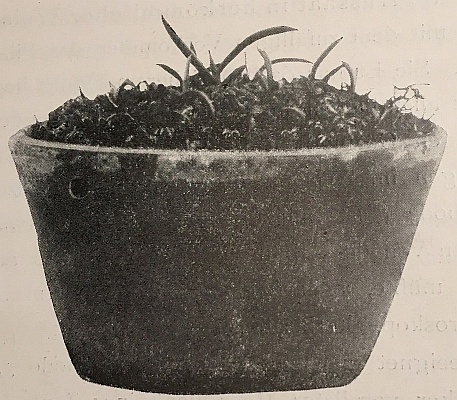
In addition to the book published in 1911, Hans Burgeff wrote in 1935 another yet more detailed book "Samenkeimung der Orchideen und Entwicklung ihrer Keimpflanzen" (Burgeff 1935). In it he deals very closely with the role of gungus symbiosis in orchids and also describes the method of fungus-free (asymbiotic) sowing, which was discovered in 1922 by Lewis Knudson. In asymbiotic sowing, the fungus is omitted and all substances supplied by the fungus are added to the medium. Since these nutrient media are much more nutritious than those used for the culture of the symbiotic fungi, sterile techniques have to get appied. A simple treatment with steam is no longer enough - it must be worked absolutely sterile. The nutrient media are sterilized under the influence of heat and pressure in a pressure cooker or autoclave. To prevent contamination of the sterilized glasses, all operations must be carried out under aseptic conditions. The simplest way to guarantee these conditions is to work in a stream of steam over the largest possible pot of boiling water. A modern sterile workbench provides better conditions where a fan pushes air through a very fine filter. Since the filter captures 99.99% of all contaminants, the area behind the filter is free of contaminations and can be used for flasking.
Parallel to Burgeff 's impressive work, one could also see great success in orchid seed sowing at the Schönbrunn Garden (Vienna), as can be seen in figure 5.
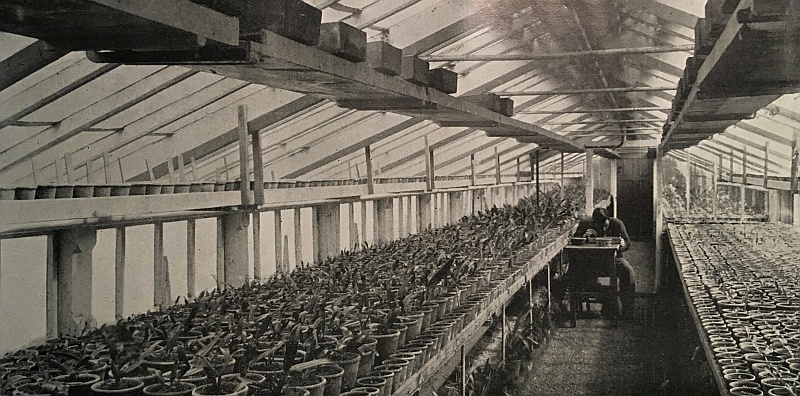
Anton Hefka, the then senior gardener, described his method of sowing in his 1914 published book "Cattleyen und Laelien – Samenzucht und Pflege" (Hefka 1914). He used 12 - 14 cm garden pots, in which the vent hole was extended to allow rapid in- and outflow of water. Half of each pot was filled with shards from pots. The shards were covered with a layer of sphagnum moss. From sawdust of healthy spruce or pine trees, he made by the addition of water a porridge, which was put into the pots two fingers thick and lightly pressed. On the surface of the sawdust the orchid seeds were scattered. The pots were placed in the glasshouse under temperate conditions and water got applied regularly. The author advises against covering the pots with glass, because the resulting conditions do not correspond to those in the natural habitat of the orchids. Since Anton Hefka does not mention in his book where the fungus needed for germination came from, one can assume that in the glasshouses there were enough imported plants with their fungi.
Most of the orchids available today are propagated without their symbiotic partner/fungus (aymbiotic). This fact, combined with the use of fungicides in the glasshouses, leads to the conclusion that symbiotic fungi are not present in our greenhouses any more. This circumstance makes it difficult for us today to apply the historical sowing methods. It would be interesting to see if there are gardeners who still use the symbiotic method on fungus-populated substrate in tropical orchids and how they proceed. Feedback would be great.
References
| Burgeff 1911 | "Die Anzucht tropischer Orchideen aus Samen" Dr. Hans Burgeff, 1911 |
| Burgeff 1935 | "Samenkeimung der Orchideen und Entwicklung ihrer Keimpflanzen" Dr. Hans Burgeff, 1935 |
| Hefka 1914 | "Cattleyen und Laelien – Samenzucht und Pflege" Anton Hefka, 1914 |
| Nelson 2002 | "Orchids of Glasnevin" Nelson & Sayers, 2002 |
Author: Thomas Ederer
